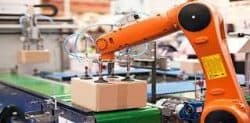Robots are the face of the future. They can perform a range of roles, from moving materials to undertaking tasks that are too dangerous for human workers. When repetitious work could cause boredom and injury, robots are ideal.
The advantages and disadvantages of robots
While using robots in manufacturing represents a significant upfront cost and requires great expertise during the initial phases, the advantages are soon apparent.
Robots can vastly improve the quality of a product, delivering a high return on investment and cost savings during the manufacturing process. They may just be the ideal investment if you want to improve your productivity.
Robot tasks
By far the most prevalent application for manufacturing robots, material handling makes up 38 percent of robot usage. The introduction of affordable collaborative robots is revolutionising production lines. These robots work side by side with humans, adding an extra element of health and safety plus productivity to their tasks.
Another 29 per cent of robots are used for welding, where they can easily automate spot and arc welding. Still others – around 10 per cent – are used for fixing, fitting, inserting and disassembling. Robots can be used for a wide range of applications, including vacuum forming and assembly using force sensing and vision systems.
Assembly, dispensing, removal and inspection
Sensing technology makes assembly robots cost-effective, enabling them to select a piece from a conveyor and fit this with another piece. Dispensing robots can place a variety of fluids, including adhesives, with great accuracy, improving product quality and reducing manufacturing time.
Robot material removers will refine a product, increase production rates and reduce costs across the finishing process, such as by refining the surface of a product after Vacuum Forming. The automation of such processes also protects human workers from exposure to harmful dust and other substances.
Robot inspection systems depend on ever-more powerful vision systems. These enable robots to verify parts assembly and detect flaws with incredible accuracy.
Affordable and mass produced
Robots are more affordable than ever before. They are mass produced to meet increasing demand and have plug-and-play functionality that makes them easier to work with than ever before. They can be applied to work in a range of industries, such as this rubber moulding UK based company www.meadex.co.uk/rubber-moulding where precision is required, as well as dangerous tasks like dealing with nuclear waste.
Robots can now communicate for greater consistency and flexibility with the result that systems are more reliable. Designed for toughness and complexity in diverse settings, robots are the future for manufacturing.



